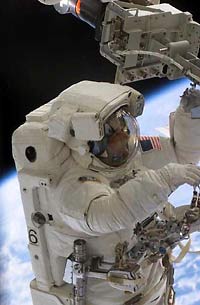Ecologist fulfills his dream with mission to space
 'I was not ready for the scale of it, to see the Earth as a planet' -Piers Sellers
An ecologist in space: Watch a webcast of Sellers' talk |
Sellers recounted his awe at watching a sunrise from the blackness of space. "The thing that impressed me the most was being outside in a space suit and listening to my breathing." Sellers said. "Pam [Pam Melroy, shuttle pilot] said, 'Sunup in one minute.' I had lost track of where the horizon was going to be.
"I turned I think forward, and the horizon suddenly appeared as a very thin blue line, at right angles, and went all the way across. The sun came up in the middle of it, just shooting up like a rocket. The earth lit up below me and I could see it moving toward me below my boots. What I could not believe was how big it is.
"When you looked at the horizon, you could see the atmosphere as a thin layer with thunderstorms half way up. The whole thing was rotating, almost rumbling beneath you. I was not ready for the scale of it, to see the Earth as a planet, not the place you're on, but to be away from it and to see it as a planet. It is really amazing."
An ecologist and biometeorologist by training, Sellers acknowledged the scientific value of the space station, but said its greater benefits are in advancing manned space exploration and fostering international relationships. "The space station is the most useful, peaceful, scientific collaboration ever done," he said.
Sellers presented his experiences at the invitation of Inez Fung, director of the Berkeley Atmospheric Sciences Center and professor of atmospheric sciences in the College of Natural Resources' Department of Environmental Science, Policy and Management.
Before joining the astronaut corps to fulfill a lifelong dream, Sellers was principal author of a classic mathematical model that encapsulates the interaction between photosynthesis and climate. He was also the leader of numerous field campaigns that combined ground and aircraft measurements and satellite observations to define how processes at the scale of stomates on leaves could be up-scaled to that observable from satellites.
Sellers and Fung were key members of the scientific team that developed the use of satellite technology and global mathematical models to study global environmental processes.

